From Toronto to Montreal through the major national parks
TORONTO > KINGSTON > OTTAWA > TREMBLANT > LAC TAUREAU > SAINT-FÉLICIEN > SAGUENAY > SACRÉ-CŒUR > BAIE-SAINT-PAUL > QUEBEC CITY > MONTRÉAL
Itinerary
-
Day 1 Toronto
 Welcome to one of Canada's largest cities: Toronto. You will feel small in front of the vastness of Ontario's capital.
Welcome to one of Canada's largest cities: Toronto. You will feel small in front of the vastness of Ontario's capital.
- Accommodation: Hotel
-
Day 2 Toronto
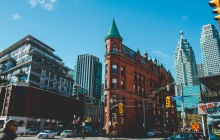 The city itself is a must-see. From art-filled streets like Graffiti Alley to the huge CN Tower, it is clearly impossible to get bored in Toronto. More of a baseball, basketball or hockey fan? Join the support teams to watch a game.
The city itself is a must-see. From art-filled streets like Graffiti Alley to the huge CN Tower, it is clearly impossible to get bored in Toronto. More of a baseball, basketball or hockey fan? Join the support teams to watch a game.
- Accommodation: Hotel
-
Day 3 Niagara Falls
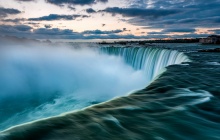 You've dreamt about them, they're here: the famous Niagara Falls! Pick up your rental car in the morning and drive to the Falls. During daytime or nighttime, on foot, by boat or even by helicopter, there are so many ways to discover them. The most difficult part is to choose!
You've dreamt about them, they're here: the famous Niagara Falls! Pick up your rental car in the morning and drive to the Falls. During daytime or nighttime, on foot, by boat or even by helicopter, there are so many ways to discover them. The most difficult part is to choose!
- Transport: 128km - about 1h30
- Accommodation: Hotel -
Day 4 Toronto / 1000 islands
 Explore the lovely historic city of Kingston, located east of Lake Ontario on the St Laurence River and discover the Thousand Islands: an archipelago of 1,865 islands spread along the river.
Explore the lovely historic city of Kingston, located east of Lake Ontario on the St Laurence River and discover the Thousand Islands: an archipelago of 1,865 islands spread along the river.
Suggested activity(ies) ($):
-Thousand Islands Cruise- Transport: 260km- about 3h
- Accommodation: Hotel -
Day 5 Quebec city / Montreal
 What could be better than visiting Montreal to end your stay in Canada? Climb Mount Royal to enjoy the surprising view of the city centre. Go down through the Mile-End district and enjoy a brunch (maple syrup pancakes are wonderfully delicious there). Stroll down the streets of the Plateau and watch the sunset at the foot of Saint Joseph's Oratory.
What could be better than visiting Montreal to end your stay in Canada? Climb Mount Royal to enjoy the surprising view of the city centre. Go down through the Mile-End district and enjoy a brunch (maple syrup pancakes are wonderfully delicious there). Stroll down the streets of the Plateau and watch the sunset at the foot of Saint Joseph's Oratory.
- Transport: 262 km - about 3h
- Accommodation: Hotel -
Day 6 Montréal
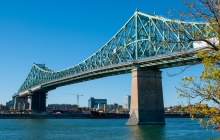 Walk or cycle through the city. Do not hesitate to visit the Old Port district, where you will find the famous great wheel and the imposing Notre-Dame Basilica.
Walk or cycle through the city. Do not hesitate to visit the Old Port district, where you will find the famous great wheel and the imposing Notre-Dame Basilica.
- Accommodation: Hotel
-
Day 7 1000 islands / Ottawa
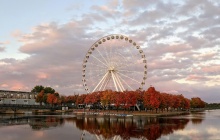 More low-key than its neighbours Toronto and Montreal, the capital of Ottawa is a city full of culture. You will find many museums in the city centre. Have fun riding from Ontario to Quebec across the Ottawa River.
More low-key than its neighbours Toronto and Montreal, the capital of Ottawa is a city full of culture. You will find many museums in the city centre. Have fun riding from Ontario to Quebec across the Ottawa River.
- Transport: 196km - about 2h
- Accommodation: Hotel -
Day 8 Ottawa / Mont-Tremblant
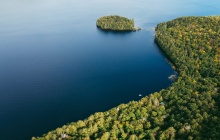 Mont-Tremblant is located in the Laurentians region, a mountain range northwest of Montreal. The Mont-Tremblant ski resort on the shores of Lake Tremblant is open all year round. You can practice a wide range of activities (golf, via ferrata, canoeing, etc.) or follow one of the many hiking trails.
Mont-Tremblant is located in the Laurentians region, a mountain range northwest of Montreal. The Mont-Tremblant ski resort on the shores of Lake Tremblant is open all year round. You can practice a wide range of activities (golf, via ferrata, canoeing, etc.) or follow one of the many hiking trails.
- Transport: 155km - about 2h
- Accommodation: Hotel -
Day 9 Mont-Tremblant National Park
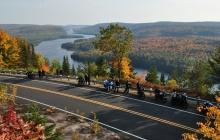 Mont-Tremblant's vast national park is located north of the city. The landscape is incredible. You can go on a forest hike and navigate the lakes by canoe.
Mont-Tremblant's vast national park is located north of the city. The landscape is incredible. You can go on a forest hike and navigate the lakes by canoe.
- Accommodation: Hotel
-
Day 10 Lake Taureau / St Jean Lake
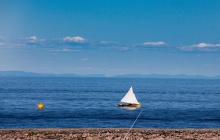 St-Jean lake is the perfect place for swimming, sailing, fishing or taking a cruise ... It is your turn to discover its major attractions such as the well-known St-Félicien's Wildlife Zoo and the splendid historic village of Val-Jalbert.
St-Jean lake is the perfect place for swimming, sailing, fishing or taking a cruise ... It is your turn to discover its major attractions such as the well-known St-Félicien's Wildlife Zoo and the splendid historic village of Val-Jalbert.
Suggested activity(ies) ($):
-Visit the historic village of Val-Jalbert- Transport: 465 km - about 5h30
- Accommodation: Hotel -
Day 11 St-Jean Lake
 With thousands of kilometers of trails and breathtaking views, the St-Jean Lake region is a real paradise for nature lovers.
With thousands of kilometers of trails and breathtaking views, the St-Jean Lake region is a real paradise for nature lovers.
- Accommodation: Hotel
-
Day 12 St Jean Lake / Saguenay
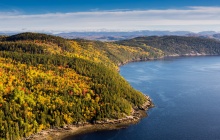 Saguenay is located at the gateway to the impressive Saguenay Fjord, under the omnipresent eye of the Mount Valin massif. It has no less than three national parks.
Saguenay is located at the gateway to the impressive Saguenay Fjord, under the omnipresent eye of the Mount Valin massif. It has no less than three national parks.
- Transport: 126 km - about 1h30
- Accommodation: Hotel -
Day 13 Saguenay
 Created by nature, the stunning waters surrounded by the dizzying cliffs of the Fjord are breathtaking. Many pedestrian and nautical activities are at your disposal to discover the Fjord.
Created by nature, the stunning waters surrounded by the dizzying cliffs of the Fjord are breathtaking. Many pedestrian and nautical activities are at your disposal to discover the Fjord.
- Accommodation: Hotel
-
Day 14 Saguenay / Sacré Cœur
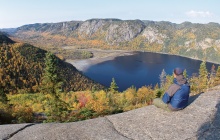 Tonight, you will be immersed in the middle of nature. You will sleep with your head in the clouds in a cabin in the trees.
Tonight, you will be immersed in the middle of nature. You will sleep with your head in the clouds in a cabin in the trees.
- Transport: 130 km - about 1h30
- Accommodation: Hotel -
Day 15 Sacré Cœur / La Malbaie
 Baie Saint Paul will allow you to discover the wonderful Charlevoix region. You can taste many local products by visiting the city's cider works, dairy or bakery.
Baie Saint Paul will allow you to discover the wonderful Charlevoix region. You can taste many local products by visiting the city's cider works, dairy or bakery.
Suggested activity(ies) ($)
- Whale watching cruise- Transport: 137 km - about 2h30
- Accommodation: Hotel -
Day 16 Baie-Saint-Paul
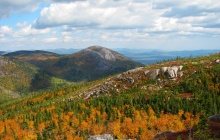 Head for the île aux coudres! Spend the day discovering the secrets and history of this island. Don't forget to visit the mills!
Head for the île aux coudres! Spend the day discovering the secrets and history of this island. Don't forget to visit the mills!
- Accommodation: Hotel
-
Day 17 Baie-Saint-Paul / Quebec city
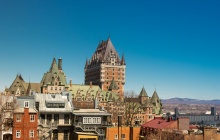 You will then be seduced by the narrow cobbled streets of Quebec City. The picturesque old town is also listed as a UNESCO World Heritage Site. You can' t miss the Château Frontenac which dominates above the city.
You will then be seduced by the narrow cobbled streets of Quebec City. The picturesque old town is also listed as a UNESCO World Heritage Site. You can' t miss the Château Frontenac which dominates above the city.
- Transport: 100 km - about 1h30
- Accommodation: Hotel -
Day 18 Quebec city
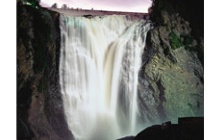 Montmorency Falls is located a few steps from Quebec City. Follow the panoramic tour to admire the 83 m high waterfall and even cross the hanging bridge above it to feel its full strength.
Montmorency Falls is located a few steps from Quebec City. Follow the panoramic tour to admire the 83 m high waterfall and even cross the hanging bridge above it to feel its full strength.
- Accommodation: Hotel
-
Day 19 Montréal
 Enjoy your last moments here before your return flight.
Enjoy your last moments here before your return flight.
-
Day 20 Lake Taureau
 A canoe ride on a lake? A walk in the middle of nature? Choose your means of transport and take the time to enjoy the calm of this region.
A canoe ride on a lake? A walk in the middle of nature? Choose your means of transport and take the time to enjoy the calm of this region.
- Accommodation: Lodge
-
Day 21 Mont-Tremblant / Lake Taureau
 This next stop will take you away from the crowd in Saint-Michel-des-Saints. The many lakes and great hikes will immerse you in this Canadian postcard.
This next stop will take you away from the crowd in Saint-Michel-des-Saints. The many lakes and great hikes will immerse you in this Canadian postcard.
- Transport: 185km - about 2h30
-Accommodation: Lodge
Period & budget
When to travel?
The best period for travelling is during the following months:
| Jan | Feb | Mar | Apr | May | Jun | Jul | Aug | Sep | Oct | Nov | Dec |
Price
The budget is an indication of the price per person, subject to availability. Your local agent will send you a customized quote with the exact price. The price can vary according to availability, level of services, period of travel, number of participants, booking time frame and other items.
Included
- 20 nights accommodation
- 19 days car hire with CDW insurance and unlimited mileage
- Applicable taxes
- Assistance 24 hours phone number
Not included
- The personalized roadbook
- Flights (Available upon request)
- Gasoline
- Lunches and dinners
- Personal expenses
Terms and conditions
Booking conditions
Invoice procedure
Cancellation policy
If cancellation occurs:
- More than 31 days before departure: 20% of the total booking amount (excluding insurance and fixed fees)
- Between 30 and 21 days before departure: 35% of the total booking amount (excluding insurance and fixed fees)
- Between 20 and 14 days before departure: 50% of the total booking amount (excluding insurance and fixed fees)
- Between 13 and 7 days before departure: 75% of the total booking amount (excluding insurance and fixed fees)
- Less than 7 days before departure: 100% of the total booking amount (excluding insurance and fixed fees)
Regardless of the cancellation or contract modification date, the following fees are added to the standard cancellation terms above:
- Airfare fees: If your flight ticket has to be issued well in advance—often to secure the best fare—100% of the non-refundable flight costs will be charged in case of cancellation or change. In this case, the standard cancellation terms apply only to the land portion of the trip.
- Land service fees: Any non-refundable fees incurred early for firm bookings will be charged in case of cancellation.
- Insurance: Whether you purchased multi-risk or cancellation insurance, the insurance premium is non-refundable under any circumstances.
The date the written notice is received will be considered the official cancellation date and will determine the applicable cancellation fees.
Altaï Canada may also cancel a trip due to exceptional circumstances considered force majeure (e.g., volcanic eruptions, social unrest, strikes, severe weather) that could compromise the safety of participants. In such cases, all amounts paid will be fully refunded, but no additional compensation can be claimed.
Changes to travel contract
Pricing
Contract transfer
Insurance
Practical info
Staff
- A day by day (itinerary) description
- Destination description
- Useful tips on driving
- Cities and parks maps
- Activities description
Food
Accommodation
Transportation
Budget & exchange
Tips
Supplied equipment
Luggage
Passport
Health information & recommendations
Weather
Electricity
Local time
Topography
Sustainable tourism
- A fair economical repartition
- The improvement of local teams’ working conditions and their awareness of the protection of the environment
- The information of travelers about respecting the local population and environment and the collection of their feelings at their return.
- Avoid letting waste out, throw it in the trash can or bring it with you
- Use potable water sparingly (take a shower instead of a bath and report any leaks) and avoid wasting it (use biodegradable soap to wash yourself)
- Avoid damaging cultural sites: don’t touch the statues, don’t move the stones and objects
- Exchange instead of giving (too Important gifts can destabilize the local economic stability of the country depending on their living standards)
- When taking a walk, especially in some fragile ecosystems, observe the fauna from afar, do not go beyond beaten roads, limit stamping and do not bring any souvenirs: give up picking rare flowers picking fossils...
- In some hotels, you can have individual air conditioning. It is advised to systematically switching it off when you’re out of the room to avoid energetical overconsumption and greenhouse gas emission.


